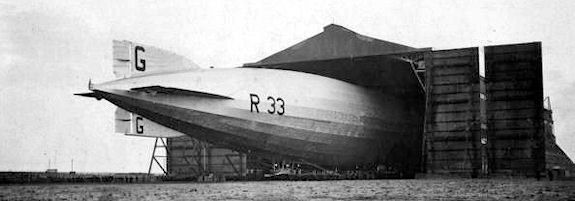
In the run up to WWI, it was recognised that the slow and unreliable airplanes of the time were not capable of protecting East coast shipping lanes from German submarines. A crash programme was instituted to protect the coastal regions with a chain of airship stations out of reach of German guns.
In 1912, the land agents Thomas Gaze and Son were given secret orders to acquire land for the establishment of an Air Station for the Admiralty in Pulham St. Mary and Rushall and 500 acres were cleared and levelled by civilian contractors and the Air Construction Corps. One hundred Royal Naval personnel arrived in 1915, with three thousand on site by 1918.
Simple small hydrogen-filled airships were built - the 'Coastal' twin-engined vessel was slow, difficult to manoeuvre and carried a 'car' comprising two aeroplane fuselages mounted back to back with a crew of five. In 1917 Pulham became an experimental unit and received two very large steel-framed sheds to house the new "rigid" airships - following the downing of one of the latest German Zeppelins, the L33, in North Essex, naval engineers recorded every detail of her construction and from their drawings, Britain's first really modern "rigid" airship, the R33, was built at Selby and arrived at Pulham. The R34, built on the Clyde, followed. After experimental work in mooring airships to masts, Pulham's 36.6m (120 ft) high mast was the first in Europe.
The Airship Service was dismantled in 1921, due to lack of funds, and one of the large hangars dismantled and re-erected at Cardington where it was enlarged (see entry for Cardington Airship Works). Pulham was tasked to explore the commercial use of airships, exploiting a revolutionary revolving top masthead which allowed ships to ride into the prevailing wind and undertaking pioneering work on air-dropping suspended aircraft. Following disastrous civilian flights, culminating in the crash of the R101 in 1930, Britain's airship programme was abandoned. During WWII the station was used as a dump for crashed aircraft from all over the east of England, with parts salvaged for reuse. Munitions testing was also conducted on the site. It remained in RAF ownership until 1958, then returned to commercial and agricultural use. It was not until 1948 that the huge shed was dismantled, a major landmark on the Norfolk skyline since 1917. Foundations of all three sheds are intact and the sites of the mooring mast, the silicol plant building, the steam-raising plant and the foundations of the gasholders have been located.
By road: Off A 143

Coates, Tim, R101, The Airship Disaster, ISBN-10: 0117024074 (1999
Chamberlain, Geoffrey Airships: Cardington, Terence Dalton ISBN-10: 0861380258 (1984)
Donne, Michael, Pioneers of the Skies: A History of Short Brothers, Nicholson and Bass, ASIN: B000ZRT0HC (1987)
Higham, Robin The British Rigid Airship, 1908-1931, London, G. T. Foulis & Co (1961)
Mowthorpe, Charles Battlebags, Allan Sutton Publishing, (1995
Ventry, Lord & Koesnik, Eugene M. Airship Saga, Poole and Dorset, Blandford Press, ISBN 0-7137-1001-2 (1982)